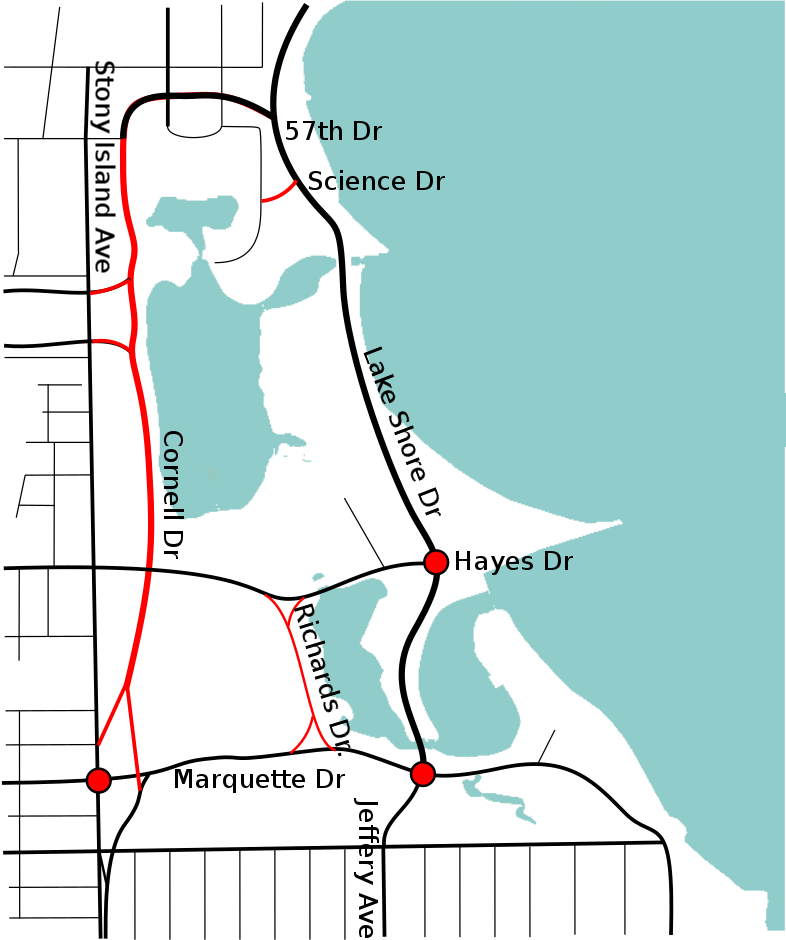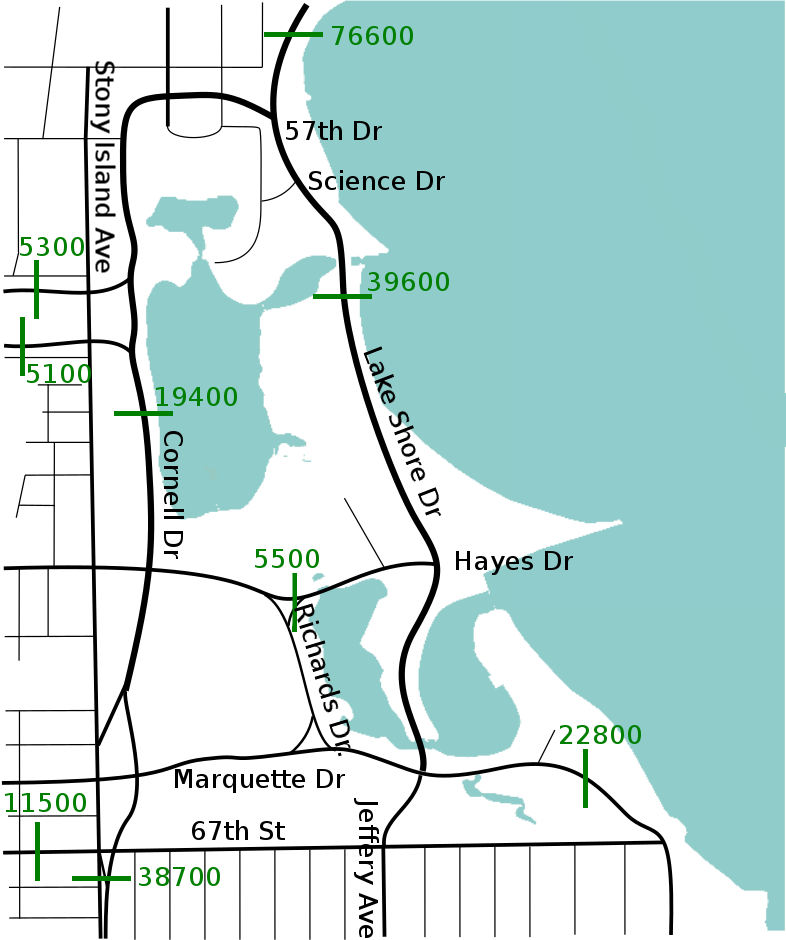Public meetings about the siting of an Obama Presidential Library on the south side have captured headlines this week: DNAinfo, Chicago Tribune Hyde Park Herald, Chicago Tonight, The Economist, … I attended and testified at the Parks Board meeting at Hyde Park High School this last Tuesday. Nearly everyone in attendance was for “bringing it on home”, albeit with some reservations about ensuring community benefits, and some opponents solidly against using any park land for the library or any loss of open space.
I strongly disagree with several assumptions made by opponents of placing the library on park land, the most fundamental of which is that total park acreage is an important measure of a park’s value. As Jane Jacobs so rhetorically put it,
Ask a houser how his planned neighborhood improves on the old city and he will cite, as a self-evident virtue, More Open Space. Ask a zoner about the improvements in progressive codes and he will cite, again as a self-evident virtue, their incentives toward leaving More Open Space. Walk with a planner through a dispirited neighborhood and though it be already scabby with deserted parks and tired landscaping festooned with old Kleenex, he will envision a future of More Open Space.
More Open Space for what? For muggings? For bleak vacuums between buildings? Or for ordinary people to use and enjoy? But people do not use city open space just because it is there and because city planners or designers wish they would.
— The Death and Live of Great American Cities, Ch. 5.
I support locating the presidential library in Jackson or Washington parks with the reservation that it should add to the usefulness of the park. The best way to do so is not necessarily by adding park acreage. The library will have to be integrated into both the urban and the park environments. While the architects for the library bid indicated that proximity to transit was essential for adequate access to the library, they also stated that a 20 acre site was required, and used the site size of previous library campuses to make their case. Given that a sea of parking surrounds most other presidential libraries, I’m strongly suspicious of the bid’s motive for requesting such a large parcel and a covenant needs to be placed on any land transfer from the parks district disallowing the construction of any new parking.
Jackson Park has many world-recognized attractions and a deep history including the Museum of Science and Industry, world’s fair monuments, fishing, large fields, tennis courts, basketball courts, an 18-hole golf course, driving range, beaches, lawn bowling, and a japanese garden. Even Yoko Ono is working to improve the park. Despite these attractions, the park is underused and has a history of neglect. I live right across the street from the park, yet I use it far less often than parks several miles from me. When I want to have a sense of open space, such as when I proposed, I go to the 39th Street Beach instead. Most of Jackson Park is difficult for surrounding neighbourhoods to access as it is surrounded by highways, especially Cornell Drive. Cornell Drive is not only dangerous and difficult to cross by foot, but its vehicle noise disrupts the serenity that one would wish to have in the park. It overwhelms the peaceful noise of water, birds, or leaves when I visit the japanese garden. Cornell Drive became a monster road in 1965 under the pretext of safety while sacrificing pedestrian access and 10% of the park’s trees. This was certainly not part of Olmstead’s vision.
I specifically mentioned in my testimony at the public hearing that we should use the opportunity provided by the presidential library to remove Cornell Drive from the park. The removal would more than offset any loss of parkland the library would cause. Otherwise, the library would occupy one of the few sites in the park one doesn’t have to cross Cornell Drive to access. An editorial in the Chicago Tribune suggested that Cornell should be relocated underground, but I believe removing the drive is feasible and much less expensive.
In several previous plans and reconstructions of road through Jackson Park, the option of closing Cornell Drive had not been considered. IDOT considers Cornell a ‘Strategic Regional Arterial’ and produced a report examining construction options in 1996. This led to a full reconstruction of Lake Shore Drive and other roads in Jackson Park in 2002. In the 1996 report, the barrier created by traffic on Cornell Drive was recognized, but no proposal to remove this barrier was considered. Rather, a proposed relocation of Cornell Drive onto a widened Stony Island was proposed that would have separated even more of the park from the community. This report emphasized ‘Improved traffic operational efficiency’ as a key goal, and would not have considered road closure an option.
Roadways through Jackson Park have Average Annual Daily Traffic counts as shown below measured in 2010 and 2013 by IDOT.
I propose the roadway closures and modifications to the intersections shown in red below.

Proposed roadway closures to improve park access. The intersections marked with red dots would require modifications as described in the text.
These changes would calm traffic on all roads through the park except Lake Shore and Marquette Drives. On these two drives, traffic lights are removed and access points limited in order to maintain adequate road capacity. The intersections of Lake Shore Drive and Hayes may be either closed or made right-turn only. The parking lot on the east side of the intersection should be closed. Marquette between Stony Island and Cornell would become westbound only with two left turning lanes and a third left or right lane. Through movement would not be permitted in order to calm Marquette Road west of the intersection so that it may continue to be used as a bike route. A new 25 mph curve would be constructed from northbound Cornell onto eastbound Marquette.
Capacity along Lake Shore Drive between Marquette and 57th would need to be increased. This segment did handle 53800 vehicles in a day during the 2006 reconstruction of the Dan Ryan expressway, demonstrating sufficient capacity to handle 50%-75% of the traffic currently on Cornell with the existing road configuration. As mentioned in the 1996 IDOT report, traffic volumes were limited by traffic signals at 57th and Marquette, not by the road width. With the removal of some traffic lights, an increase in green time for through traffic at 57th, and a right turn only restriction from westbound Marquette at Lake Shore Drive, there should be sufficient capacity to fully handle the diverted volume. The additional traffic volume along Marquette would necessitate the installation of new grade separated pedestrian crossings for the Golf Course and on at least 3 of 4 sides at Lake Shore Drive. While this proposal would strain the available capacity of Lake Shore Drive through Jackson Park, it is fairly cheap to implement and would have immense benefits to park users.
Who would lose out in such a reconstruction? Drivers continuing down Stony Island will no longer bypass queuing that occurs during rush hour at the intersection with Marquette. Traffic currently accessing Lake Shore Drive from either 63rd or Midway Plaisance would have to divert a short distance on Stony Island before accessing a fast arterial. Commuters between the University of Chicago and Indiana would no longer be able to cross the intersection of Marquette and Lake Shore Drive and may find it easier to take the Skyway instead. Vehicles travelling west from the South Shore neighbourhood would have to use city streets instead of cutting through the park. Some traffic will also divert onto the north to west left turn at 57th Street likely beyond its current capacity. Finally, developers of the old US Steel site would have an even more difficult time glossing over their transportation plan. Mind you, their site transportation plan is filled with problems anyways, a topic for a future post.


